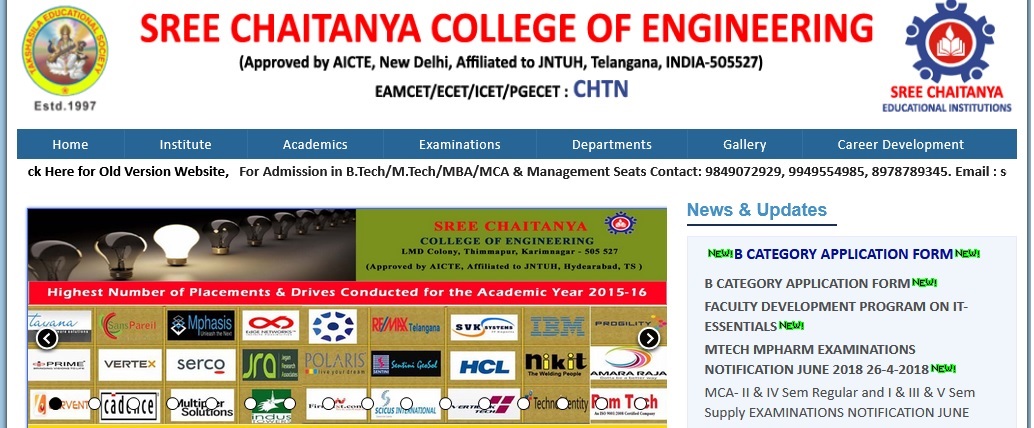07A70110 Remote Sensing & GIS Applications B.Tech Question Paper : scce.ac.in
Name of the College : SREE CHAITANYA COLLEGE OF ENGINEERING
University : JNTUH
Department : Civil Engineering
Subject Code/Name :07A70110/REMOTE SENSING AND GIS APPLICATIONS
Year/Sem : IV/I
Website : scce.ac.in
Document Type : Model Question Paper
Download Model/Sample Question Paper : https://www.pdfquestion.in/uploads/scce.ac.in/4897-07A70110-REMOTESENSINGANDGISAPPLICATIONS.pdf
SCCE Remote Sensing Question Paper
IV B.Tech I Semester Examinations,December 2011
Time: 3 hours
Max Marks: 80
Related : Sree Chaitanya College Of Engineering 07A70109 Ground Improvement Techniques B.Tech Question Paper : www.pdfquestion.in/4898.html
Set No. 1
Answer any FIVE Questions :
All Questions carry equal marks :
1. (a) Describe various types of rainfall – runo relations and parameters involved in each of them.
(b) Mention atleast four rainfall – runo models and discuss their amenability to satellite data. [8+8]
2. Explain the operations of whiskbroom and push broom scanner systems with the help of neat sketches. [16]
3. What are the most important aspects of a map for communicating information? What makes a good map? How should you choose colours and grey scales for displaying data? Explain the key board entry process of data. [16]
4. Explain in detail about:
(a) GIS work flow process with the help of a flow diagram and (b) Cognitive models. [16]
5. (a) Write any five disadvantages of using remotely sensed data.

(b) Explain:
i. Planck’s law and
ii. Wein’s displacement law. Also write the relevant mathematical expressions. [10+6]
6. Define photogrammetry. Write about the evolution of photogrammetry and importance of photogrammetry in real world phenomenon. [16]
7. Write short notes on the following:
(a) Inland water quality.
(b) Drainage morphometry.
(c) Artificial recharge structures.
(d) Fluvial geomorphology. [4×4]
8. Describe the three raster GIS models. Explain the advantages and disavantages of each. [16]
Set No. 2
Code No: 07A70110
R07
1. (a) What are the data types used in GIS? What are the sources in India for getting these data sets?
(b) What are the methods for inputting data to GIS? Describe automatic scanner for inputting data. [4+12]
2. Explain various contributing disciplines in GIS. [16]
3. What are the various parameters that can be taken to target the ground water prospects in a region? [16]
4. (a) Define remote sensing with the help of a neat sketch.
(b) List the different remote sensing applications related to Civil Engineering. [8+8]
5. Explain the following:
(a) Land use and land cover
(b) Floods and drought. [16]
6. Explain the following raster models:
(a) MAP GIS data model.
(b) MAGI model. [16]
7. Explain the method of determination of ground coordinated from measured photo coordinates with the help of a neat sketch. [16]
8. Differentiate between digital image analysis and visual image analysis. [16]
Remote Sensing And GIS Applications :
1. Discuss the following photogrammetric activities:
(a) Determining horizontal ground distances and angles from measurements made on a vertical photograph.
(b) Use of ground control points.
(c) Preparation of a flight plan to acquire aerial photography.
(d) Determination of object heights from the measurements of relief displacements. ments. [16]
2. Define watershed and its characteristics for management and development. Support your answer with examples. [16]
3. Describe by means of a neat sketch, the components of an ideal remote sensing system. [16]
4. Write short notes on:
(a) Topology
(b) Attributes
(c) Geographical entities. Give three examples for each. [16]
5. List and explain any two vector data models. [16]
6. Write short notes on:
(a) Spatial and radiometric resolutions
(b) Along track scanners
(c) Satellite visual interpretation techniques. [16]
7. Explain, in general terms, what an object-oriented GIS is and indicate its potential advantagaes over other systems. [16]
8. (a) Discuss dierent drainage patterns found in watersheds and their characteristics.
(b) Which satellite data you prefer in identifying drainage characteristics and why? [8+8]
Set No. 3
1. Explain in detail the signicance of:
(a) Four M0s of GIS with the help of a schematic representation
(b) GIS categories. [16]
2. (a) Describe the geographical techniques for ground water exploration.
(b) What are the parameters to test the quality of ground water? [8+8]
3. Describe types of GIS attribute databases. Support your answer with examples. [16]
4. Explain along with a flow chart how remote sensing is useful for the preparation of watershed management for a given watershed. [16]
5. Describe the process of quantizing space into equal-sized rasters called grid cells. What impact does grid cell size have on the locational accuracy? How would you store points, lines, and polygons using a raster system?